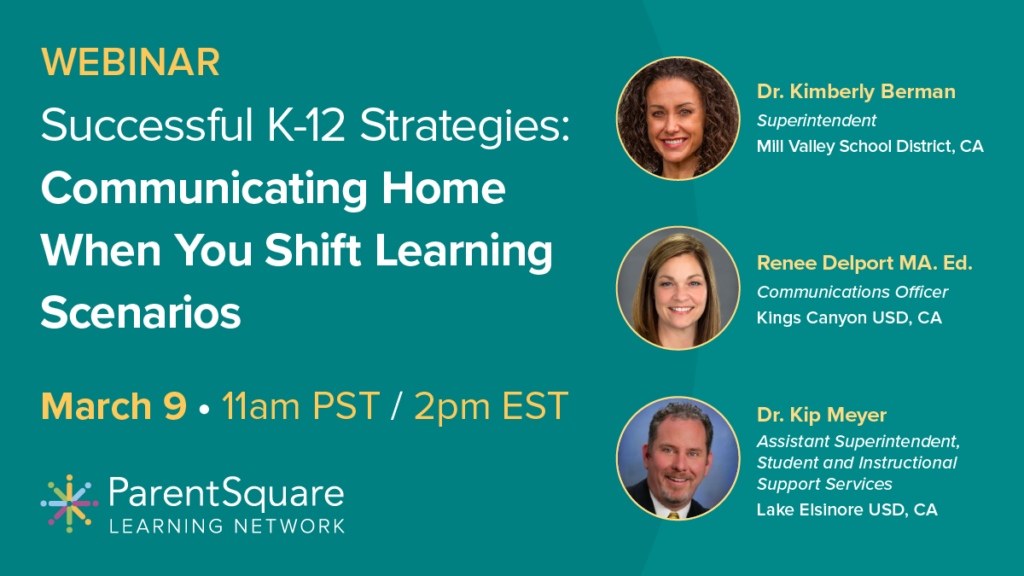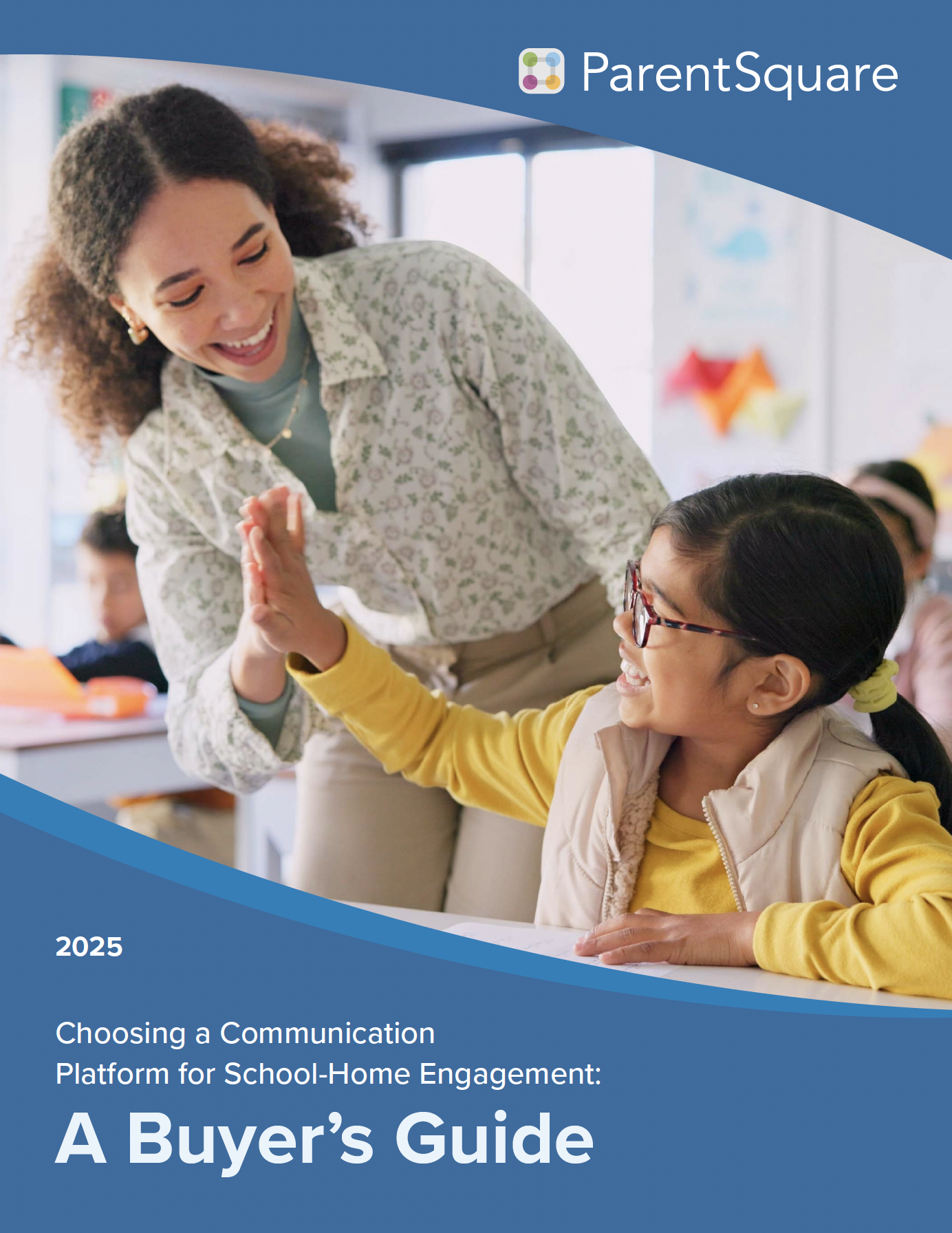
While the recent returns to school can be exciting for parents, students, and staff, they also raise a number of questions and concerns for school and district leaders. How do you support students and families as learning scenarios shift? How do you keep everyone informed and engaged with important instructional and COVID-19-related information? And, most importantly, how do you keep everyone safe?
At our recent webinar, Successful K-12 Strategies: Communicating Home When You Shift Learning Scenarios, we heard from Dr. Kimberly Berman, Superintendent of Mill Valley School District, CA, Renee Delport, Communications Officer for Kings Canyon USD, CA, and Dr. Kip Meyer, Assistant Superintendent of Lake Elsinore USD, CA. They shared what they’ve learned about communicating during shifting learning scenarios.
Read on for highlights from the conversation, including strategies for connecting with the hardest-to-reach families, tips for managing COVID-19 protocols, and ways to combat parental message fatigue.
Q: What learning scenarios have you supported this school year? How have communications been affected?
Like many other schools and districts, it has not been a traditional year for the panelists, and their methods of instruction have changed multiple times since the onset of the pandemic.
For Kimberly and Renee, their districts started the school year off completely remote and then shifted to a hybrid model after a few months. This shift to hybrid learning required a lot of planning and great care to ensure everyone’s needs were taken into account and that it would be a safe transition for all.
Kimberly explained that collaboration was vital in creating a successful hybrid plan. They established a task force with staff members to discuss what went well when they went remote last spring and then decide what changes to implement for a hybrid model. They also met with the union and the school board to create return plans. In addition, they held forums with the principals and met with school sites via Zoom to answer questions and address concerns. Finally, they utilized surveys to gather feedback and evaluate what was working and what was not.
Renee explained that they tackled the shift to hybrid learning with strong communications tools. Before the 2020-2021 school year, they did not have a unified communications platform. When COVID-19 hit and the district could no longer communicate with students in person, it became even more necessary to adopt a comprehensive communications tool. Kings Canyon USD launched ParentSquare last August, and it has been instrumental in allowing them to get information out to their schools during shifting learning scenarios. With ParentSquare, they can quickly disseminate information, answer questions, and keep parents informed.

COMMUNICATIONS OFFICER, KINGS CANYON USD
“We have been able to adopt a unified communications platform at every level of our district… I would say going forward this has really been a positive for our district…and one that everyone needed.”
—Renee Delport MA.Ed., Communications Officer, Kings Canyon Unified School District
On the other hand, Kip’s county is still experiencing high rates of COVID-19, so a majority of students are still remote. To be successful with remote learning, he suggests addressing your “internal community,” or staff members, first. Try to find out what their needs are and answer their questions. Once your staff has the information they need, you can present a unified front, and everyone can help with external communication to parents.
Q: How do you communicate and include hard-to-reach families in light of your current learning scenario(s)?
Renee is a firm believer that equitable communications should be a priority for all schools and districts. Her district utilizes a multi-tiered system of communication to reach everyone.
First, they have their baseline communication, where they communicate important information to everyone. Since Kings Canyon’s contactability rates are between 99-100%, they can confidently reach many of their families with their baseline communication. Renee explained that the time spent working with ParentSquare to ensure they had accurate contact information has been worth it because they know parents are receiving district communications.
After sending out baseline communications, they monitor messages for parent engagement. And finally, if parents did not engage with their message, they follow up with phone calls or individual meetings. Kings Canyon found that parents often just need extra help learning how to use the platform to engage with district messaging.
“We believe in equity in all areas of our district, so communication is the same way. We need to be sure that we are providing the help that people need. And some people maybe need more help than others, and we just want to be sure that we’re providing the support that our families need in order to be able to engage in their students’ education.”
—Renee Delport MA. Ed., Communications Officer, Kings Canyon Unified School District
Similarly, Kimberly also monitors who engages with Mill Valley’s communications like the parent newsletters. They have found that their average open rate is 65% (a remarkable statistic, compared to the standard 23%). They also utilize the ParentSquare’s Forms feature to gather information about parent preferences and needs. If a parent does not fill out the form, Mill Valley follows up with a phone call.
Kip also suggests taking the extra steps to individually reach out to parents who are not engaging with messages. He recommends utilizing your staff, such as bus drivers, to personally connect with your hardest-to-reach students who may need a safe in-person visit from a familiar face.
Q: How do you maintain community/parent trust? How do you keep families connected?
To keep families connected to school, panelists shared that it’s important to continue offering virtual opportunities for students to connect. For example, virtual talent shows, science fairs, and guest speaker events are fun and effective ideas.
What’s more, Kimberly explained that they had record numbers of families attend virtual events. They found that the virtual nature allows students, aunts, uncles, and other family members who may be across the country to tune in. Also, their board meetings used to have 15-30 participants in-person, but they now have 180-300 participants online! They are considering continuing to stream Board meetings, so they are accessible to all parents.
Another important way to build trust and engagement is through consistent communications that address parents’ questions and needs. Kip suggests developing FAQs for parents and staff, and Kimberly recommends using social media to spread information and combat misinformation that can sometimes spread throughout school communities.

“Trust really comes from your teachers, staff, and site principals. What we have found is, the more our sites engage, the more trust is kept and garnered.” —Dr. Kip Meyer, Assistant Superintendent, Lake Elsinore Unified School District.
Q: What is your district doing to communicate and manage health screening, as well as staff testing/vaccinations?
Kip, Kimberly, and Renee all utilize ParentSquare’s Health Screening Form, which allows them to screen students and staff for COVID-19 symptoms or exposure before they step on campus. Kimberly and Renee also remind parents to fill out the health screening every day via ParentSquare’s Notification and Alerts.
Kimberly also uses the daily health screening reminder as an opportunity to showcase her students. Students can submit jokes, poems, or other short notes to be included with the morning reminder, and it’s a great way to help kids feel included and make the notifications a little more fun.

“We use the ParentSquare Health Screening, and we send a reminder every morning at 7 a.m. To get people to see that reminder and think about it differently, we’ve had kids submit jokes or poems or other short quips that they would like to be included on that…it’s a really fun way to spotlight our kids.” — Dr. Kimberly Berman, Superintendent, Mill Valley School District
Beyond health screenings, they also have a plan for when a student or staff member is exposed to COVID-19. Kimberly has an online dashboard on the school website to see information about positive cases, possible quarantines, and exposures. They follow all contact tracing and quarantine procedures when there is a possible case of COVID-19 or confirmed transmission.
Q: Are your communities experiencing message fatigue? Where’s the balance between too much and too little?
Renee explained how it is essential that parents engage with communications right now because it is critical for schools and districts. They share essential information about instructional methods and safety guidelines, so parents cannot afford to ignore the information.
To combat message fatigue, Renee’s district created a clear plan for the messages they would send home, how they would send them home, to whom, and when. They focus on two levels of communications: district and school. The superintendent sends out initial announcements, and then school sites reiterate the information and fill in the gaps. By establishing a clear protocol, they ensure that all information is conveyed, but not repeating or overloading parents with messaging.
Another way to ensure that parents do not experience an overload of messages but can still get all the information they need is to utilize Daily Digest settings in ParentSquare. Through this feature, parents can get a daily digest of all school communications in one email every night at 6 p.m., rather than one by one. Also, emergency notifications can push past this setting so that urgent or time-sensitive information gets to parents.
Finally, Kip suggests focusing on absorbability. Rather than sharing long documents with information, share the key points, so it’s easier to read. He also explains that social media and infographics are great ways to improve engagement.
Q: What tips do you have for other schools and districts shifting learning scenarios?
First, Kimberly reminds us that it’s essential to stay positive and celebrate small successes along the way. Focus on the positives and all the ways that you have helped your students during these challenging times! For example, Kimberly’s district had the first day of school celebrations on their first day of remote learning and then again on the first day of hybrid learning, which was a fun way to maintain a positive atmosphere.
“It’s been really important to celebrate the next steps within the district and remember that you will hear the dissent a lot more than you will hear the agreement. It’s somewhat important to remember to focus on what you’re doing for kids…so you can continue to persist and push forward.” —Dr. Kimberly Berman, Superintendent, Mill Valley School District
Renee also suggests staying positive. She shared that the shift towards hybrid learning was stressful, but once everyone was back on campus, it was all worth it, and the stress faded away.
“I promise for those of you who have not come back yet, somehow once the doors open and the kids walk on, that anxiety starts to subside a little bit.” —Renee Delport MA. Ed., Communications Officer, Kings Canyon Unified School District
Finally, Kip noted that you have to work together as a unified team to tackle any parent, student, or staff concerns that may arise. Developing a sense of collaboration and allowing everyone’s input to be valued is the key to success moving forward because no one can do this alone.
“As you are beginning to bring back your staff and students, develop a lot of committees and input and allow your leaders to really lead. This isn’t a time period for one person, two people, five people, to run the show. This is really about where we need to all come together, put our heads together, listen to the concerns, what the needs are, and really address them.”—Dr. Kip Meyer, Assistant Superintendent, Lake Elsinore Unified School District
We thank our wonderful panelists for providing their invaluable insight. We hope you found some helpful tips and tricks as you continue the journey back to campus. If you have additional advice to add to the conversation, we’d love to hear from you in the comments below!







